Strategy and Society: CSR, Coca-Cola, and Pepsi Analysis
VerifiedAdded on 2020/05/11
|23
|6411
|62
Report
AI Summary
This report examines the critical link between competitive advantage and Corporate Social Responsibility (CSR), using a case study approach focused on the corporate strategies of Coca-Cola and Pepsi. The report delves into the CSR activities of both companies, exploring how these initiatives align with their overall business strategies and impact their competitive positions. It incorporates relevant theoretical frameworks such as the Triple Bottom Line theory, Stakeholder theory, and Porter’s theory of competitive advantage to provide a comprehensive understanding of the subject matter. The research methodology employs a case study approach, collecting and analyzing data to identify the connection between CSR and competitive advantage. The findings highlight how CSR practices influence brand image, customer loyalty, and overall organizational growth. The report concludes with recommendations for integrating CSR into business strategies to enhance competitive advantage and includes a detailed literature review covering key CSR concepts. The report provides insights into the role of CSR in creating a positive brand image and gaining support from stakeholders.
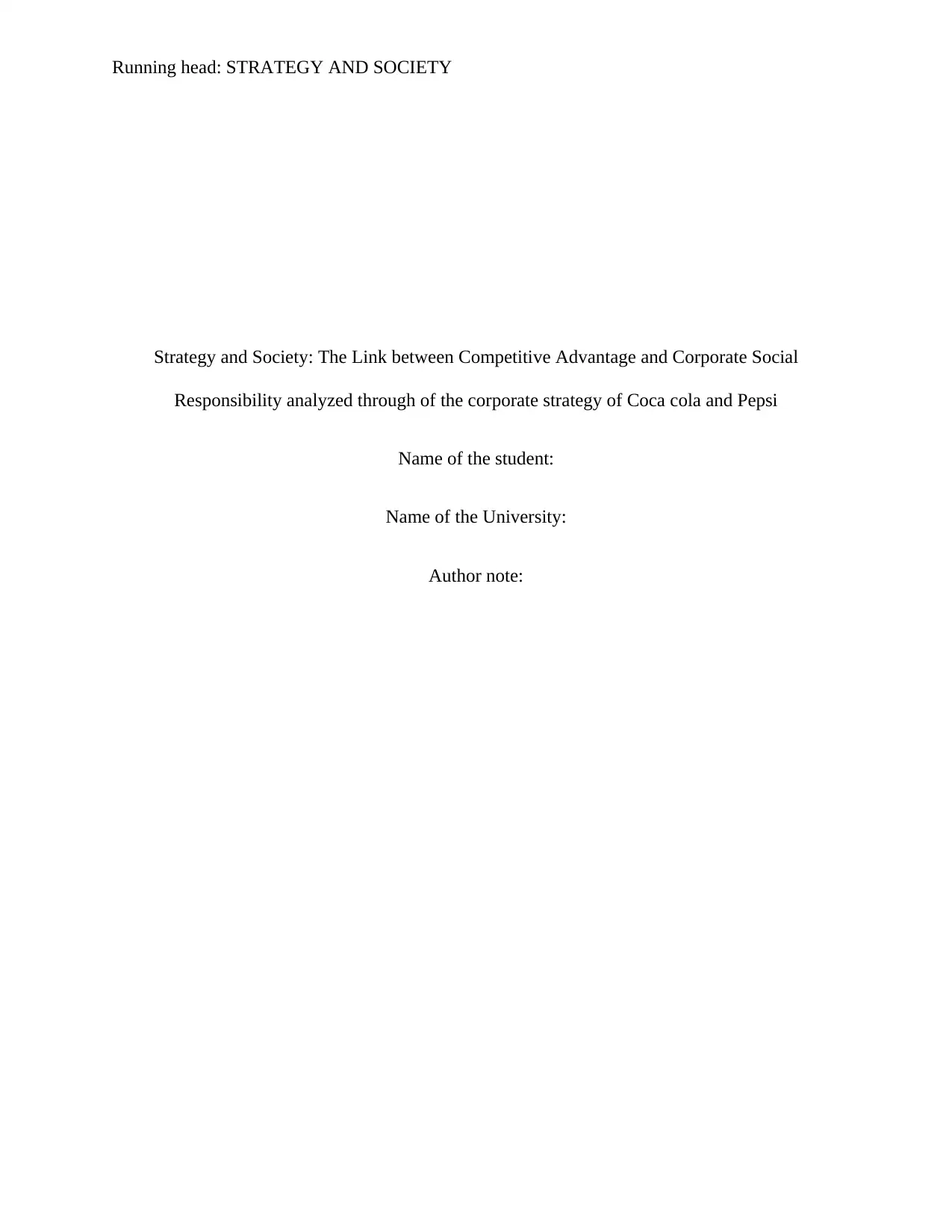
Running head: STRATEGY AND SOCIETY
Strategy and Society: The Link between Competitive Advantage and Corporate Social
Responsibility analyzed through of the corporate strategy of Coca cola and Pepsi
Name of the student:
Name of the University:
Author note:
Strategy and Society: The Link between Competitive Advantage and Corporate Social
Responsibility analyzed through of the corporate strategy of Coca cola and Pepsi
Name of the student:
Name of the University:
Author note:
Paraphrase This Document
Need a fresh take? Get an instant paraphrase of this document with our AI Paraphraser
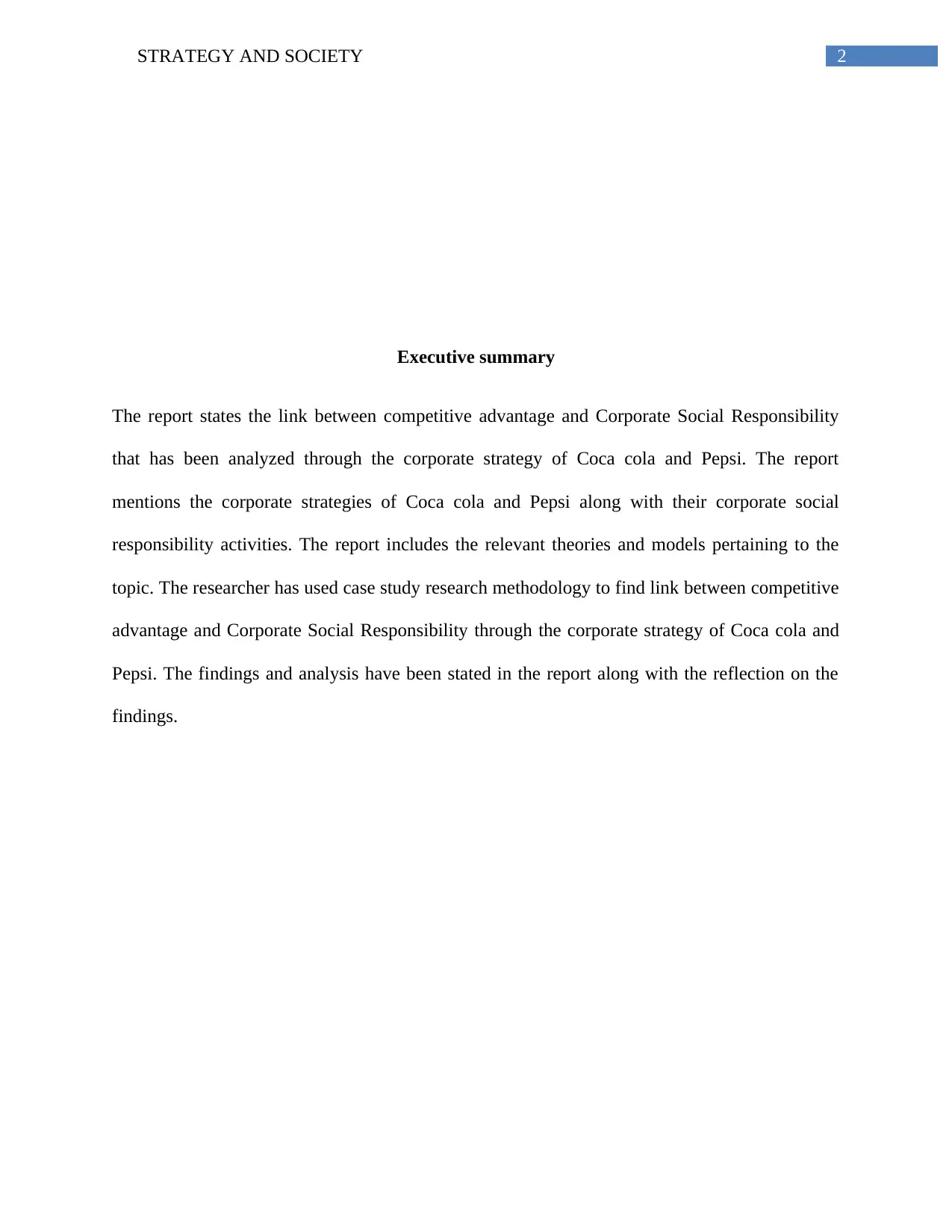
2STRATEGY AND SOCIETY
Executive summary
The report states the link between competitive advantage and Corporate Social Responsibility
that has been analyzed through the corporate strategy of Coca cola and Pepsi. The report
mentions the corporate strategies of Coca cola and Pepsi along with their corporate social
responsibility activities. The report includes the relevant theories and models pertaining to the
topic. The researcher has used case study research methodology to find link between competitive
advantage and Corporate Social Responsibility through the corporate strategy of Coca cola and
Pepsi. The findings and analysis have been stated in the report along with the reflection on the
findings.
Executive summary
The report states the link between competitive advantage and Corporate Social Responsibility
that has been analyzed through the corporate strategy of Coca cola and Pepsi. The report
mentions the corporate strategies of Coca cola and Pepsi along with their corporate social
responsibility activities. The report includes the relevant theories and models pertaining to the
topic. The researcher has used case study research methodology to find link between competitive
advantage and Corporate Social Responsibility through the corporate strategy of Coca cola and
Pepsi. The findings and analysis have been stated in the report along with the reflection on the
findings.
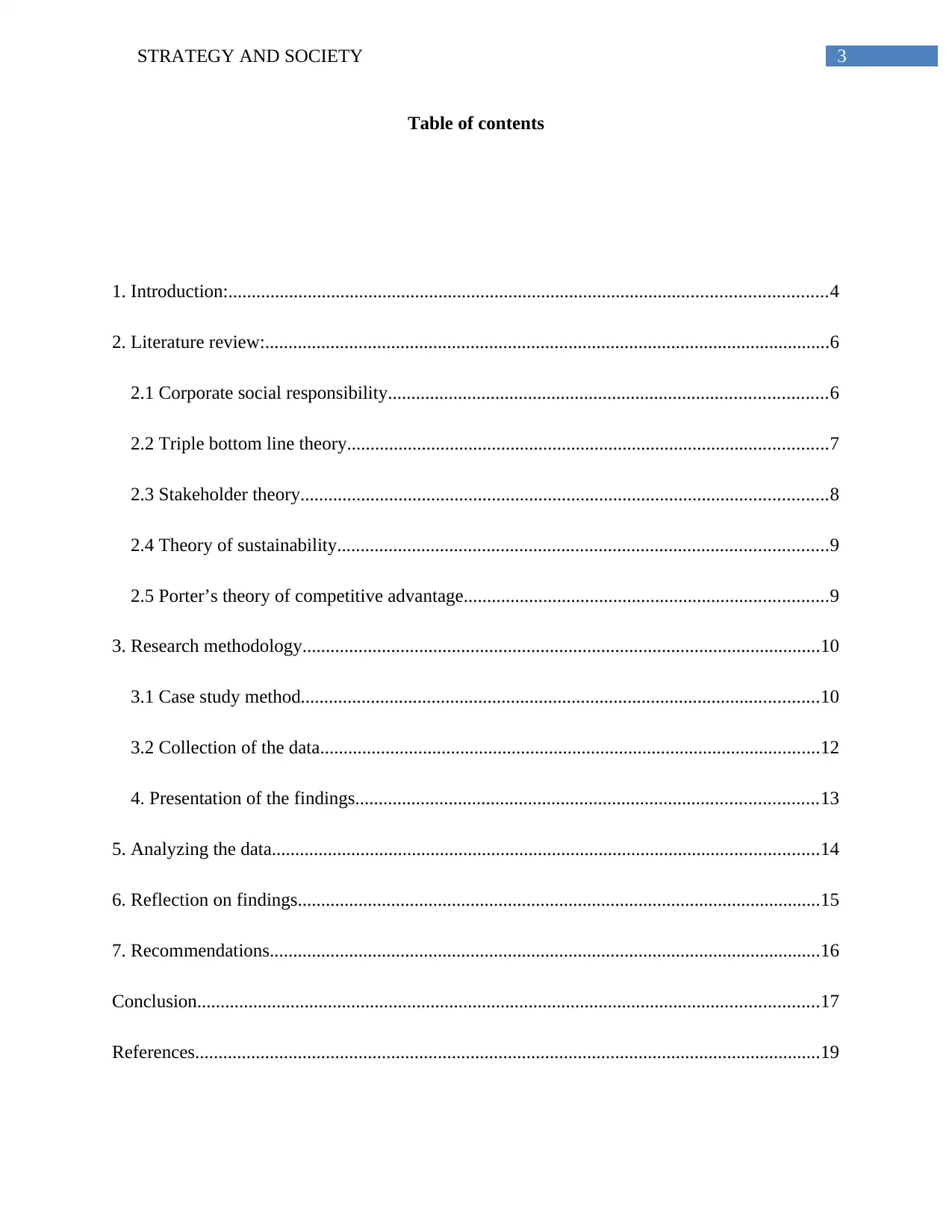
3STRATEGY AND SOCIETY
Table of contents
1. Introduction:................................................................................................................................4
2. Literature review:.........................................................................................................................6
2.1 Corporate social responsibility..............................................................................................6
2.2 Triple bottom line theory.......................................................................................................7
2.3 Stakeholder theory.................................................................................................................8
2.4 Theory of sustainability.........................................................................................................9
2.5 Porter’s theory of competitive advantage..............................................................................9
3. Research methodology...............................................................................................................10
3.1 Case study method...............................................................................................................10
3.2 Collection of the data...........................................................................................................12
4. Presentation of the findings...................................................................................................13
5. Analyzing the data.....................................................................................................................14
6. Reflection on findings................................................................................................................15
7. Recommendations......................................................................................................................16
Conclusion.....................................................................................................................................17
References......................................................................................................................................19
Table of contents
1. Introduction:................................................................................................................................4
2. Literature review:.........................................................................................................................6
2.1 Corporate social responsibility..............................................................................................6
2.2 Triple bottom line theory.......................................................................................................7
2.3 Stakeholder theory.................................................................................................................8
2.4 Theory of sustainability.........................................................................................................9
2.5 Porter’s theory of competitive advantage..............................................................................9
3. Research methodology...............................................................................................................10
3.1 Case study method...............................................................................................................10
3.2 Collection of the data...........................................................................................................12
4. Presentation of the findings...................................................................................................13
5. Analyzing the data.....................................................................................................................14
6. Reflection on findings................................................................................................................15
7. Recommendations......................................................................................................................16
Conclusion.....................................................................................................................................17
References......................................................................................................................................19
⊘ This is a preview!⊘
Do you want full access?
Subscribe today to unlock all pages.

Trusted by 1+ million students worldwide
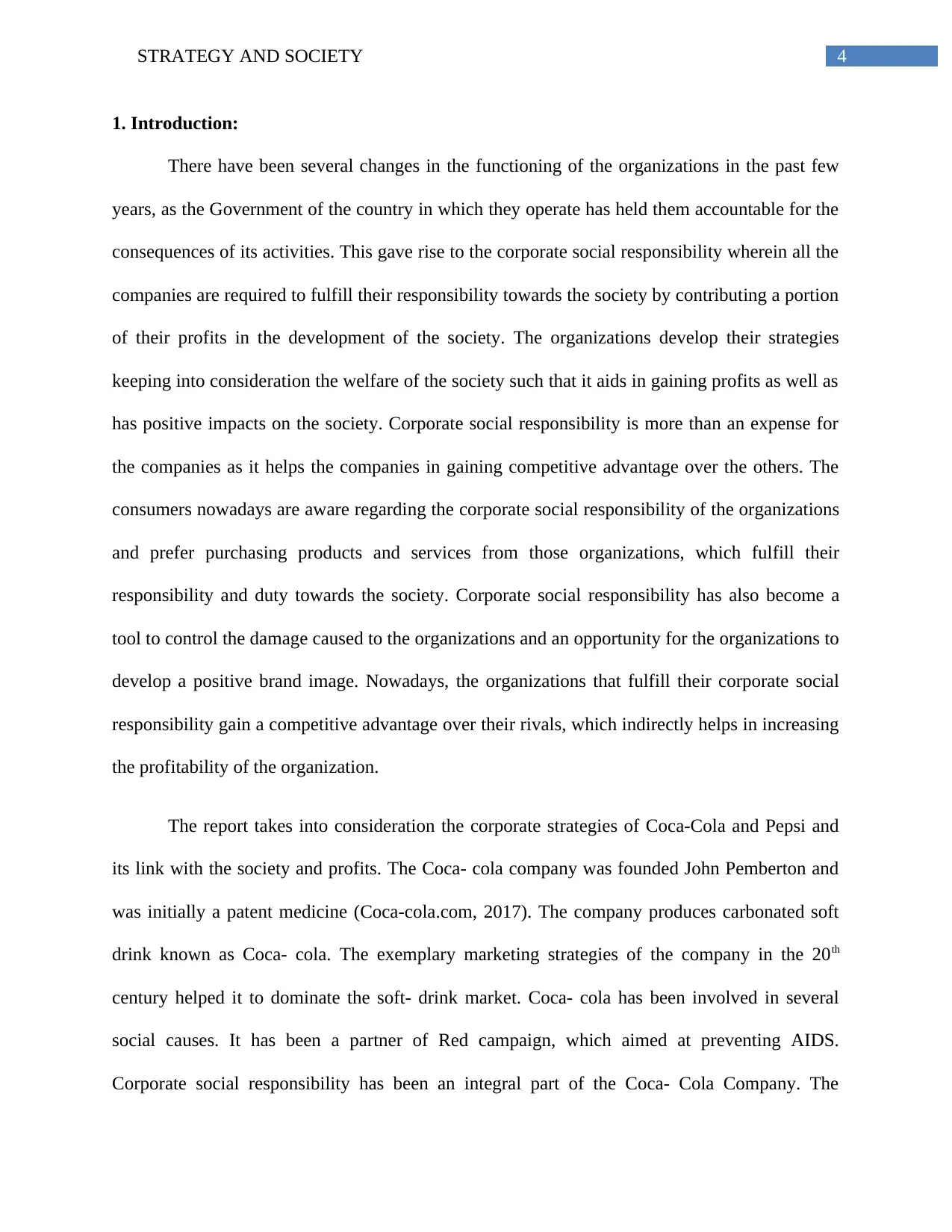
4STRATEGY AND SOCIETY
1. Introduction:
There have been several changes in the functioning of the organizations in the past few
years, as the Government of the country in which they operate has held them accountable for the
consequences of its activities. This gave rise to the corporate social responsibility wherein all the
companies are required to fulfill their responsibility towards the society by contributing a portion
of their profits in the development of the society. The organizations develop their strategies
keeping into consideration the welfare of the society such that it aids in gaining profits as well as
has positive impacts on the society. Corporate social responsibility is more than an expense for
the companies as it helps the companies in gaining competitive advantage over the others. The
consumers nowadays are aware regarding the corporate social responsibility of the organizations
and prefer purchasing products and services from those organizations, which fulfill their
responsibility and duty towards the society. Corporate social responsibility has also become a
tool to control the damage caused to the organizations and an opportunity for the organizations to
develop a positive brand image. Nowadays, the organizations that fulfill their corporate social
responsibility gain a competitive advantage over their rivals, which indirectly helps in increasing
the profitability of the organization.
The report takes into consideration the corporate strategies of Coca-Cola and Pepsi and
its link with the society and profits. The Coca- cola company was founded John Pemberton and
was initially a patent medicine (Coca-cola.com, 2017). The company produces carbonated soft
drink known as Coca- cola. The exemplary marketing strategies of the company in the 20th
century helped it to dominate the soft- drink market. Coca- cola has been involved in several
social causes. It has been a partner of Red campaign, which aimed at preventing AIDS.
Corporate social responsibility has been an integral part of the Coca- Cola Company. The
1. Introduction:
There have been several changes in the functioning of the organizations in the past few
years, as the Government of the country in which they operate has held them accountable for the
consequences of its activities. This gave rise to the corporate social responsibility wherein all the
companies are required to fulfill their responsibility towards the society by contributing a portion
of their profits in the development of the society. The organizations develop their strategies
keeping into consideration the welfare of the society such that it aids in gaining profits as well as
has positive impacts on the society. Corporate social responsibility is more than an expense for
the companies as it helps the companies in gaining competitive advantage over the others. The
consumers nowadays are aware regarding the corporate social responsibility of the organizations
and prefer purchasing products and services from those organizations, which fulfill their
responsibility and duty towards the society. Corporate social responsibility has also become a
tool to control the damage caused to the organizations and an opportunity for the organizations to
develop a positive brand image. Nowadays, the organizations that fulfill their corporate social
responsibility gain a competitive advantage over their rivals, which indirectly helps in increasing
the profitability of the organization.
The report takes into consideration the corporate strategies of Coca-Cola and Pepsi and
its link with the society and profits. The Coca- cola company was founded John Pemberton and
was initially a patent medicine (Coca-cola.com, 2017). The company produces carbonated soft
drink known as Coca- cola. The exemplary marketing strategies of the company in the 20th
century helped it to dominate the soft- drink market. Coca- cola has been involved in several
social causes. It has been a partner of Red campaign, which aimed at preventing AIDS.
Corporate social responsibility has been an integral part of the Coca- Cola Company. The
Paraphrase This Document
Need a fresh take? Get an instant paraphrase of this document with our AI Paraphraser
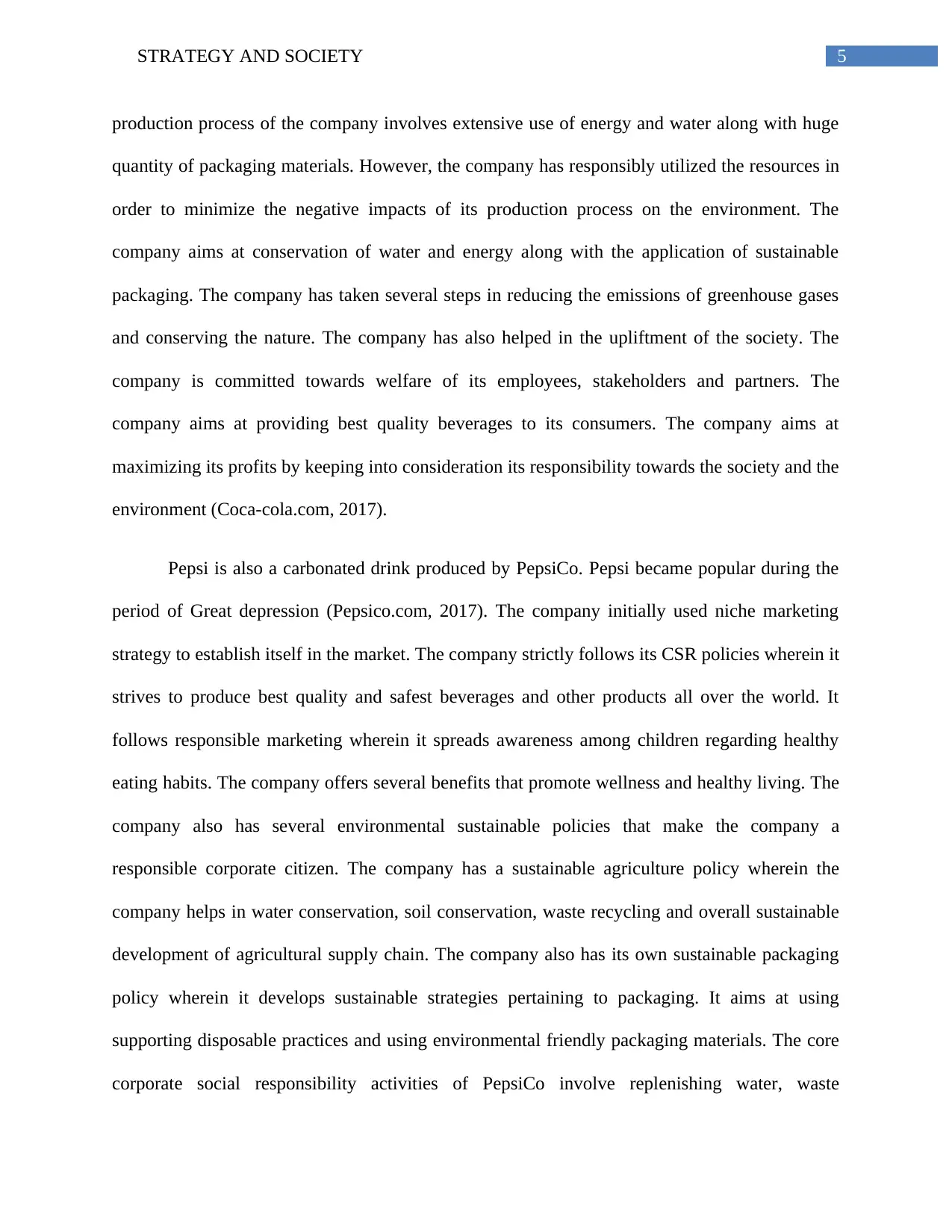
5STRATEGY AND SOCIETY
production process of the company involves extensive use of energy and water along with huge
quantity of packaging materials. However, the company has responsibly utilized the resources in
order to minimize the negative impacts of its production process on the environment. The
company aims at conservation of water and energy along with the application of sustainable
packaging. The company has taken several steps in reducing the emissions of greenhouse gases
and conserving the nature. The company has also helped in the upliftment of the society. The
company is committed towards welfare of its employees, stakeholders and partners. The
company aims at providing best quality beverages to its consumers. The company aims at
maximizing its profits by keeping into consideration its responsibility towards the society and the
environment (Coca-cola.com, 2017).
Pepsi is also a carbonated drink produced by PepsiCo. Pepsi became popular during the
period of Great depression (Pepsico.com, 2017). The company initially used niche marketing
strategy to establish itself in the market. The company strictly follows its CSR policies wherein it
strives to produce best quality and safest beverages and other products all over the world. It
follows responsible marketing wherein it spreads awareness among children regarding healthy
eating habits. The company offers several benefits that promote wellness and healthy living. The
company also has several environmental sustainable policies that make the company a
responsible corporate citizen. The company has a sustainable agriculture policy wherein the
company helps in water conservation, soil conservation, waste recycling and overall sustainable
development of agricultural supply chain. The company also has its own sustainable packaging
policy wherein it develops sustainable strategies pertaining to packaging. It aims at using
supporting disposable practices and using environmental friendly packaging materials. The core
corporate social responsibility activities of PepsiCo involve replenishing water, waste
production process of the company involves extensive use of energy and water along with huge
quantity of packaging materials. However, the company has responsibly utilized the resources in
order to minimize the negative impacts of its production process on the environment. The
company aims at conservation of water and energy along with the application of sustainable
packaging. The company has taken several steps in reducing the emissions of greenhouse gases
and conserving the nature. The company has also helped in the upliftment of the society. The
company is committed towards welfare of its employees, stakeholders and partners. The
company aims at providing best quality beverages to its consumers. The company aims at
maximizing its profits by keeping into consideration its responsibility towards the society and the
environment (Coca-cola.com, 2017).
Pepsi is also a carbonated drink produced by PepsiCo. Pepsi became popular during the
period of Great depression (Pepsico.com, 2017). The company initially used niche marketing
strategy to establish itself in the market. The company strictly follows its CSR policies wherein it
strives to produce best quality and safest beverages and other products all over the world. It
follows responsible marketing wherein it spreads awareness among children regarding healthy
eating habits. The company offers several benefits that promote wellness and healthy living. The
company also has several environmental sustainable policies that make the company a
responsible corporate citizen. The company has a sustainable agriculture policy wherein the
company helps in water conservation, soil conservation, waste recycling and overall sustainable
development of agricultural supply chain. The company also has its own sustainable packaging
policy wherein it develops sustainable strategies pertaining to packaging. It aims at using
supporting disposable practices and using environmental friendly packaging materials. The core
corporate social responsibility activities of PepsiCo involve replenishing water, waste
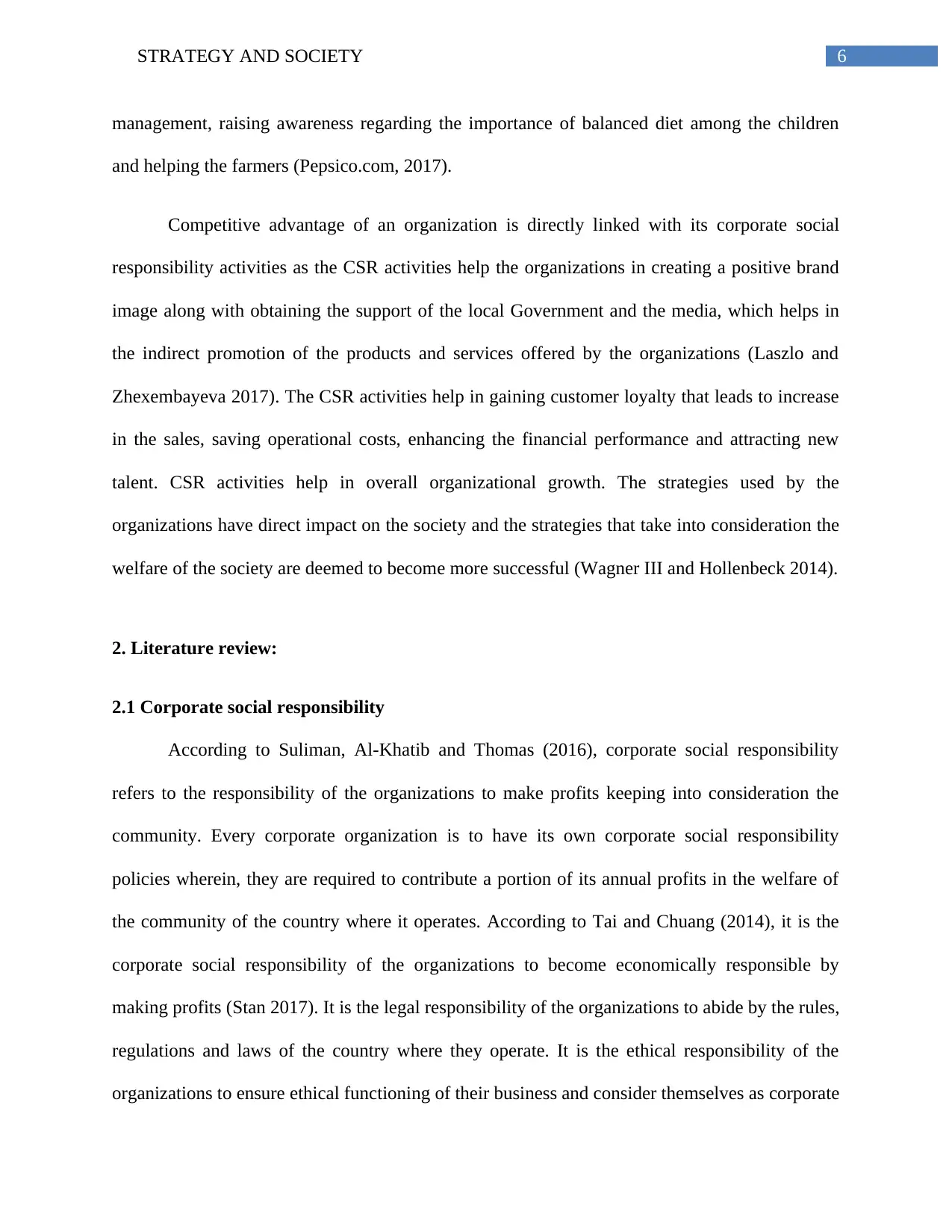
6STRATEGY AND SOCIETY
management, raising awareness regarding the importance of balanced diet among the children
and helping the farmers (Pepsico.com, 2017).
Competitive advantage of an organization is directly linked with its corporate social
responsibility activities as the CSR activities help the organizations in creating a positive brand
image along with obtaining the support of the local Government and the media, which helps in
the indirect promotion of the products and services offered by the organizations (Laszlo and
Zhexembayeva 2017). The CSR activities help in gaining customer loyalty that leads to increase
in the sales, saving operational costs, enhancing the financial performance and attracting new
talent. CSR activities help in overall organizational growth. The strategies used by the
organizations have direct impact on the society and the strategies that take into consideration the
welfare of the society are deemed to become more successful (Wagner III and Hollenbeck 2014).
2. Literature review:
2.1 Corporate social responsibility
According to Suliman, Al-Khatib and Thomas (2016), corporate social responsibility
refers to the responsibility of the organizations to make profits keeping into consideration the
community. Every corporate organization is to have its own corporate social responsibility
policies wherein, they are required to contribute a portion of its annual profits in the welfare of
the community of the country where it operates. According to Tai and Chuang (2014), it is the
corporate social responsibility of the organizations to become economically responsible by
making profits (Stan 2017). It is the legal responsibility of the organizations to abide by the rules,
regulations and laws of the country where they operate. It is the ethical responsibility of the
organizations to ensure ethical functioning of their business and consider themselves as corporate
management, raising awareness regarding the importance of balanced diet among the children
and helping the farmers (Pepsico.com, 2017).
Competitive advantage of an organization is directly linked with its corporate social
responsibility activities as the CSR activities help the organizations in creating a positive brand
image along with obtaining the support of the local Government and the media, which helps in
the indirect promotion of the products and services offered by the organizations (Laszlo and
Zhexembayeva 2017). The CSR activities help in gaining customer loyalty that leads to increase
in the sales, saving operational costs, enhancing the financial performance and attracting new
talent. CSR activities help in overall organizational growth. The strategies used by the
organizations have direct impact on the society and the strategies that take into consideration the
welfare of the society are deemed to become more successful (Wagner III and Hollenbeck 2014).
2. Literature review:
2.1 Corporate social responsibility
According to Suliman, Al-Khatib and Thomas (2016), corporate social responsibility
refers to the responsibility of the organizations to make profits keeping into consideration the
community. Every corporate organization is to have its own corporate social responsibility
policies wherein, they are required to contribute a portion of its annual profits in the welfare of
the community of the country where it operates. According to Tai and Chuang (2014), it is the
corporate social responsibility of the organizations to become economically responsible by
making profits (Stan 2017). It is the legal responsibility of the organizations to abide by the rules,
regulations and laws of the country where they operate. It is the ethical responsibility of the
organizations to ensure ethical functioning of their business and consider themselves as corporate
⊘ This is a preview!⊘
Do you want full access?
Subscribe today to unlock all pages.

Trusted by 1+ million students worldwide
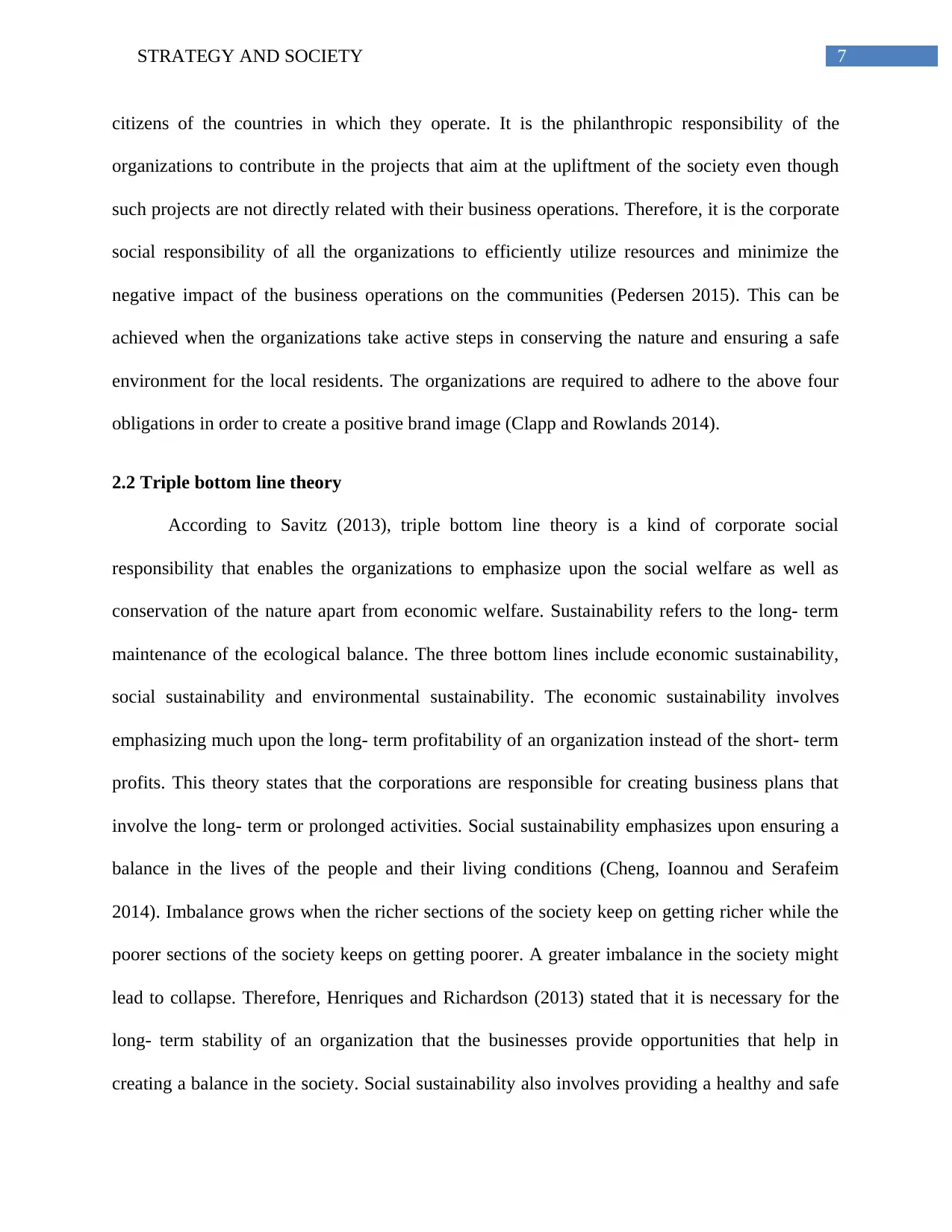
7STRATEGY AND SOCIETY
citizens of the countries in which they operate. It is the philanthropic responsibility of the
organizations to contribute in the projects that aim at the upliftment of the society even though
such projects are not directly related with their business operations. Therefore, it is the corporate
social responsibility of all the organizations to efficiently utilize resources and minimize the
negative impact of the business operations on the communities (Pedersen 2015). This can be
achieved when the organizations take active steps in conserving the nature and ensuring a safe
environment for the local residents. The organizations are required to adhere to the above four
obligations in order to create a positive brand image (Clapp and Rowlands 2014).
2.2 Triple bottom line theory
According to Savitz (2013), triple bottom line theory is a kind of corporate social
responsibility that enables the organizations to emphasize upon the social welfare as well as
conservation of the nature apart from economic welfare. Sustainability refers to the long- term
maintenance of the ecological balance. The three bottom lines include economic sustainability,
social sustainability and environmental sustainability. The economic sustainability involves
emphasizing much upon the long- term profitability of an organization instead of the short- term
profits. This theory states that the corporations are responsible for creating business plans that
involve the long- term or prolonged activities. Social sustainability emphasizes upon ensuring a
balance in the lives of the people and their living conditions (Cheng, Ioannou and Serafeim
2014). Imbalance grows when the richer sections of the society keep on getting richer while the
poorer sections of the society keeps on getting poorer. A greater imbalance in the society might
lead to collapse. Therefore, Henriques and Richardson (2013) stated that it is necessary for the
long- term stability of an organization that the businesses provide opportunities that help in
creating a balance in the society. Social sustainability also involves providing a healthy and safe
citizens of the countries in which they operate. It is the philanthropic responsibility of the
organizations to contribute in the projects that aim at the upliftment of the society even though
such projects are not directly related with their business operations. Therefore, it is the corporate
social responsibility of all the organizations to efficiently utilize resources and minimize the
negative impact of the business operations on the communities (Pedersen 2015). This can be
achieved when the organizations take active steps in conserving the nature and ensuring a safe
environment for the local residents. The organizations are required to adhere to the above four
obligations in order to create a positive brand image (Clapp and Rowlands 2014).
2.2 Triple bottom line theory
According to Savitz (2013), triple bottom line theory is a kind of corporate social
responsibility that enables the organizations to emphasize upon the social welfare as well as
conservation of the nature apart from economic welfare. Sustainability refers to the long- term
maintenance of the ecological balance. The three bottom lines include economic sustainability,
social sustainability and environmental sustainability. The economic sustainability involves
emphasizing much upon the long- term profitability of an organization instead of the short- term
profits. This theory states that the corporations are responsible for creating business plans that
involve the long- term or prolonged activities. Social sustainability emphasizes upon ensuring a
balance in the lives of the people and their living conditions (Cheng, Ioannou and Serafeim
2014). Imbalance grows when the richer sections of the society keep on getting richer while the
poorer sections of the society keeps on getting poorer. A greater imbalance in the society might
lead to collapse. Therefore, Henriques and Richardson (2013) stated that it is necessary for the
long- term stability of an organization that the businesses provide opportunities that help in
creating a balance in the society. Social sustainability also involves providing a healthy and safe
Paraphrase This Document
Need a fresh take? Get an instant paraphrase of this document with our AI Paraphraser
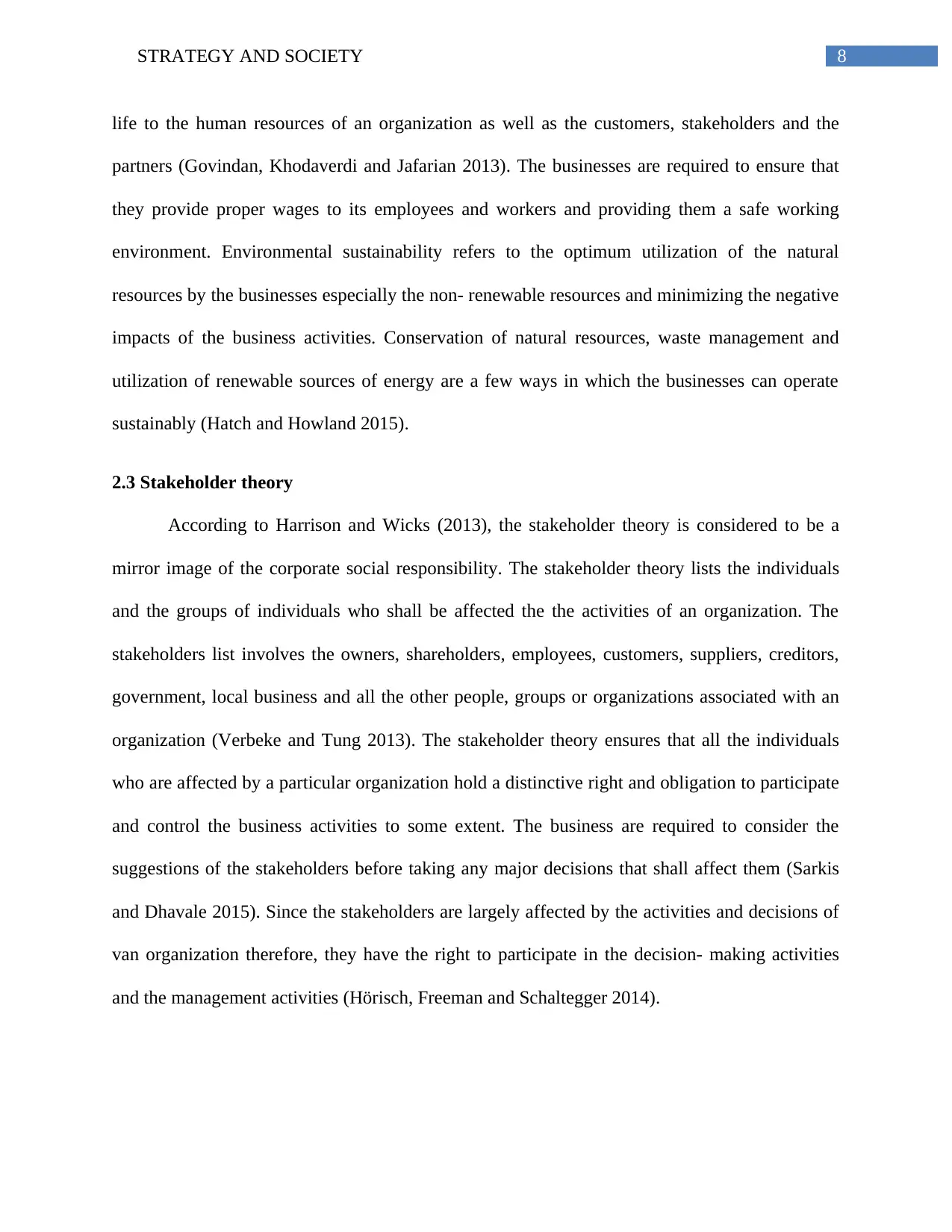
8STRATEGY AND SOCIETY
life to the human resources of an organization as well as the customers, stakeholders and the
partners (Govindan, Khodaverdi and Jafarian 2013). The businesses are required to ensure that
they provide proper wages to its employees and workers and providing them a safe working
environment. Environmental sustainability refers to the optimum utilization of the natural
resources by the businesses especially the non- renewable resources and minimizing the negative
impacts of the business activities. Conservation of natural resources, waste management and
utilization of renewable sources of energy are a few ways in which the businesses can operate
sustainably (Hatch and Howland 2015).
2.3 Stakeholder theory
According to Harrison and Wicks (2013), the stakeholder theory is considered to be a
mirror image of the corporate social responsibility. The stakeholder theory lists the individuals
and the groups of individuals who shall be affected the the activities of an organization. The
stakeholders list involves the owners, shareholders, employees, customers, suppliers, creditors,
government, local business and all the other people, groups or organizations associated with an
organization (Verbeke and Tung 2013). The stakeholder theory ensures that all the individuals
who are affected by a particular organization hold a distinctive right and obligation to participate
and control the business activities to some extent. The business are required to consider the
suggestions of the stakeholders before taking any major decisions that shall affect them (Sarkis
and Dhavale 2015). Since the stakeholders are largely affected by the activities and decisions of
van organization therefore, they have the right to participate in the decision- making activities
and the management activities (Hörisch, Freeman and Schaltegger 2014).
life to the human resources of an organization as well as the customers, stakeholders and the
partners (Govindan, Khodaverdi and Jafarian 2013). The businesses are required to ensure that
they provide proper wages to its employees and workers and providing them a safe working
environment. Environmental sustainability refers to the optimum utilization of the natural
resources by the businesses especially the non- renewable resources and minimizing the negative
impacts of the business activities. Conservation of natural resources, waste management and
utilization of renewable sources of energy are a few ways in which the businesses can operate
sustainably (Hatch and Howland 2015).
2.3 Stakeholder theory
According to Harrison and Wicks (2013), the stakeholder theory is considered to be a
mirror image of the corporate social responsibility. The stakeholder theory lists the individuals
and the groups of individuals who shall be affected the the activities of an organization. The
stakeholders list involves the owners, shareholders, employees, customers, suppliers, creditors,
government, local business and all the other people, groups or organizations associated with an
organization (Verbeke and Tung 2013). The stakeholder theory ensures that all the individuals
who are affected by a particular organization hold a distinctive right and obligation to participate
and control the business activities to some extent. The business are required to consider the
suggestions of the stakeholders before taking any major decisions that shall affect them (Sarkis
and Dhavale 2015). Since the stakeholders are largely affected by the activities and decisions of
van organization therefore, they have the right to participate in the decision- making activities
and the management activities (Hörisch, Freeman and Schaltegger 2014).
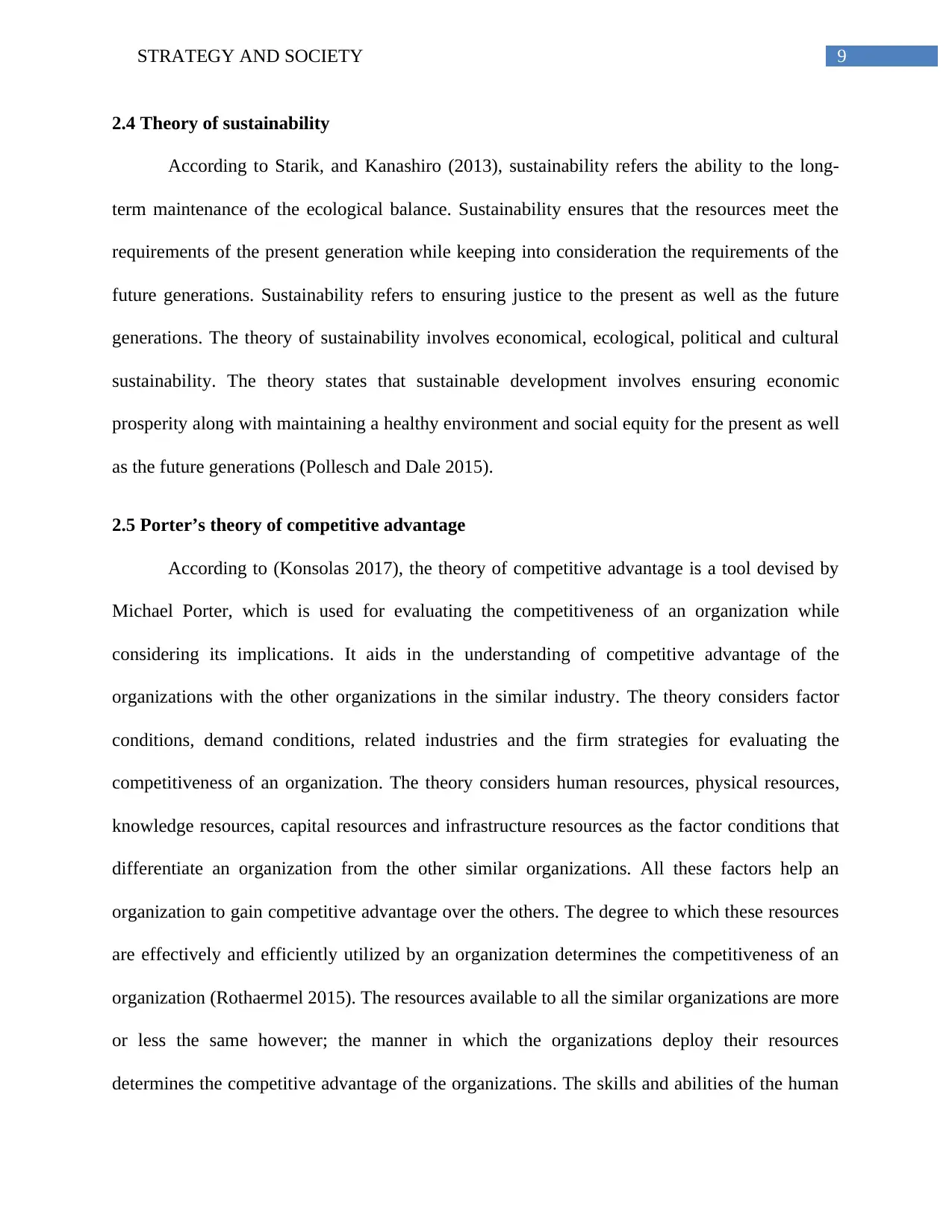
9STRATEGY AND SOCIETY
2.4 Theory of sustainability
According to Starik, and Kanashiro (2013), sustainability refers the ability to the long-
term maintenance of the ecological balance. Sustainability ensures that the resources meet the
requirements of the present generation while keeping into consideration the requirements of the
future generations. Sustainability refers to ensuring justice to the present as well as the future
generations. The theory of sustainability involves economical, ecological, political and cultural
sustainability. The theory states that sustainable development involves ensuring economic
prosperity along with maintaining a healthy environment and social equity for the present as well
as the future generations (Pollesch and Dale 2015).
2.5 Porter’s theory of competitive advantage
According to (Konsolas 2017), the theory of competitive advantage is a tool devised by
Michael Porter, which is used for evaluating the competitiveness of an organization while
considering its implications. It aids in the understanding of competitive advantage of the
organizations with the other organizations in the similar industry. The theory considers factor
conditions, demand conditions, related industries and the firm strategies for evaluating the
competitiveness of an organization. The theory considers human resources, physical resources,
knowledge resources, capital resources and infrastructure resources as the factor conditions that
differentiate an organization from the other similar organizations. All these factors help an
organization to gain competitive advantage over the others. The degree to which these resources
are effectively and efficiently utilized by an organization determines the competitiveness of an
organization (Rothaermel 2015). The resources available to all the similar organizations are more
or less the same however; the manner in which the organizations deploy their resources
determines the competitive advantage of the organizations. The skills and abilities of the human
2.4 Theory of sustainability
According to Starik, and Kanashiro (2013), sustainability refers the ability to the long-
term maintenance of the ecological balance. Sustainability ensures that the resources meet the
requirements of the present generation while keeping into consideration the requirements of the
future generations. Sustainability refers to ensuring justice to the present as well as the future
generations. The theory of sustainability involves economical, ecological, political and cultural
sustainability. The theory states that sustainable development involves ensuring economic
prosperity along with maintaining a healthy environment and social equity for the present as well
as the future generations (Pollesch and Dale 2015).
2.5 Porter’s theory of competitive advantage
According to (Konsolas 2017), the theory of competitive advantage is a tool devised by
Michael Porter, which is used for evaluating the competitiveness of an organization while
considering its implications. It aids in the understanding of competitive advantage of the
organizations with the other organizations in the similar industry. The theory considers factor
conditions, demand conditions, related industries and the firm strategies for evaluating the
competitiveness of an organization. The theory considers human resources, physical resources,
knowledge resources, capital resources and infrastructure resources as the factor conditions that
differentiate an organization from the other similar organizations. All these factors help an
organization to gain competitive advantage over the others. The degree to which these resources
are effectively and efficiently utilized by an organization determines the competitiveness of an
organization (Rothaermel 2015). The resources available to all the similar organizations are more
or less the same however; the manner in which the organizations deploy their resources
determines the competitive advantage of the organizations. The skills and abilities of the human
⊘ This is a preview!⊘
Do you want full access?
Subscribe today to unlock all pages.

Trusted by 1+ million students worldwide
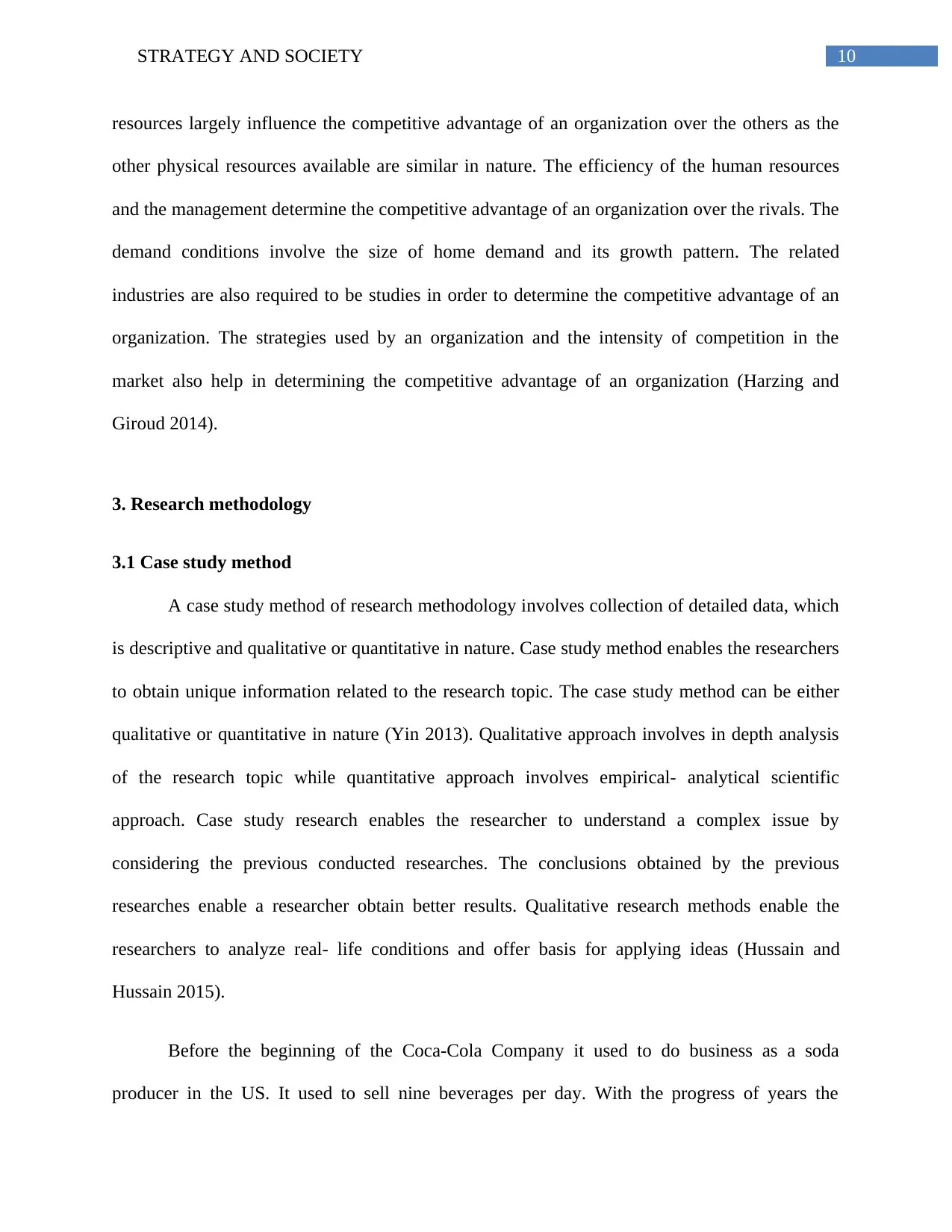
10STRATEGY AND SOCIETY
resources largely influence the competitive advantage of an organization over the others as the
other physical resources available are similar in nature. The efficiency of the human resources
and the management determine the competitive advantage of an organization over the rivals. The
demand conditions involve the size of home demand and its growth pattern. The related
industries are also required to be studies in order to determine the competitive advantage of an
organization. The strategies used by an organization and the intensity of competition in the
market also help in determining the competitive advantage of an organization (Harzing and
Giroud 2014).
3. Research methodology
3.1 Case study method
A case study method of research methodology involves collection of detailed data, which
is descriptive and qualitative or quantitative in nature. Case study method enables the researchers
to obtain unique information related to the research topic. The case study method can be either
qualitative or quantitative in nature (Yin 2013). Qualitative approach involves in depth analysis
of the research topic while quantitative approach involves empirical- analytical scientific
approach. Case study research enables the researcher to understand a complex issue by
considering the previous conducted researches. The conclusions obtained by the previous
researches enable a researcher obtain better results. Qualitative research methods enable the
researchers to analyze real- life conditions and offer basis for applying ideas (Hussain and
Hussain 2015).
Before the beginning of the Coca-Cola Company it used to do business as a soda
producer in the US. It used to sell nine beverages per day. With the progress of years the
resources largely influence the competitive advantage of an organization over the others as the
other physical resources available are similar in nature. The efficiency of the human resources
and the management determine the competitive advantage of an organization over the rivals. The
demand conditions involve the size of home demand and its growth pattern. The related
industries are also required to be studies in order to determine the competitive advantage of an
organization. The strategies used by an organization and the intensity of competition in the
market also help in determining the competitive advantage of an organization (Harzing and
Giroud 2014).
3. Research methodology
3.1 Case study method
A case study method of research methodology involves collection of detailed data, which
is descriptive and qualitative or quantitative in nature. Case study method enables the researchers
to obtain unique information related to the research topic. The case study method can be either
qualitative or quantitative in nature (Yin 2013). Qualitative approach involves in depth analysis
of the research topic while quantitative approach involves empirical- analytical scientific
approach. Case study research enables the researcher to understand a complex issue by
considering the previous conducted researches. The conclusions obtained by the previous
researches enable a researcher obtain better results. Qualitative research methods enable the
researchers to analyze real- life conditions and offer basis for applying ideas (Hussain and
Hussain 2015).
Before the beginning of the Coca-Cola Company it used to do business as a soda
producer in the US. It used to sell nine beverages per day. With the progress of years the
Paraphrase This Document
Need a fresh take? Get an instant paraphrase of this document with our AI Paraphraser
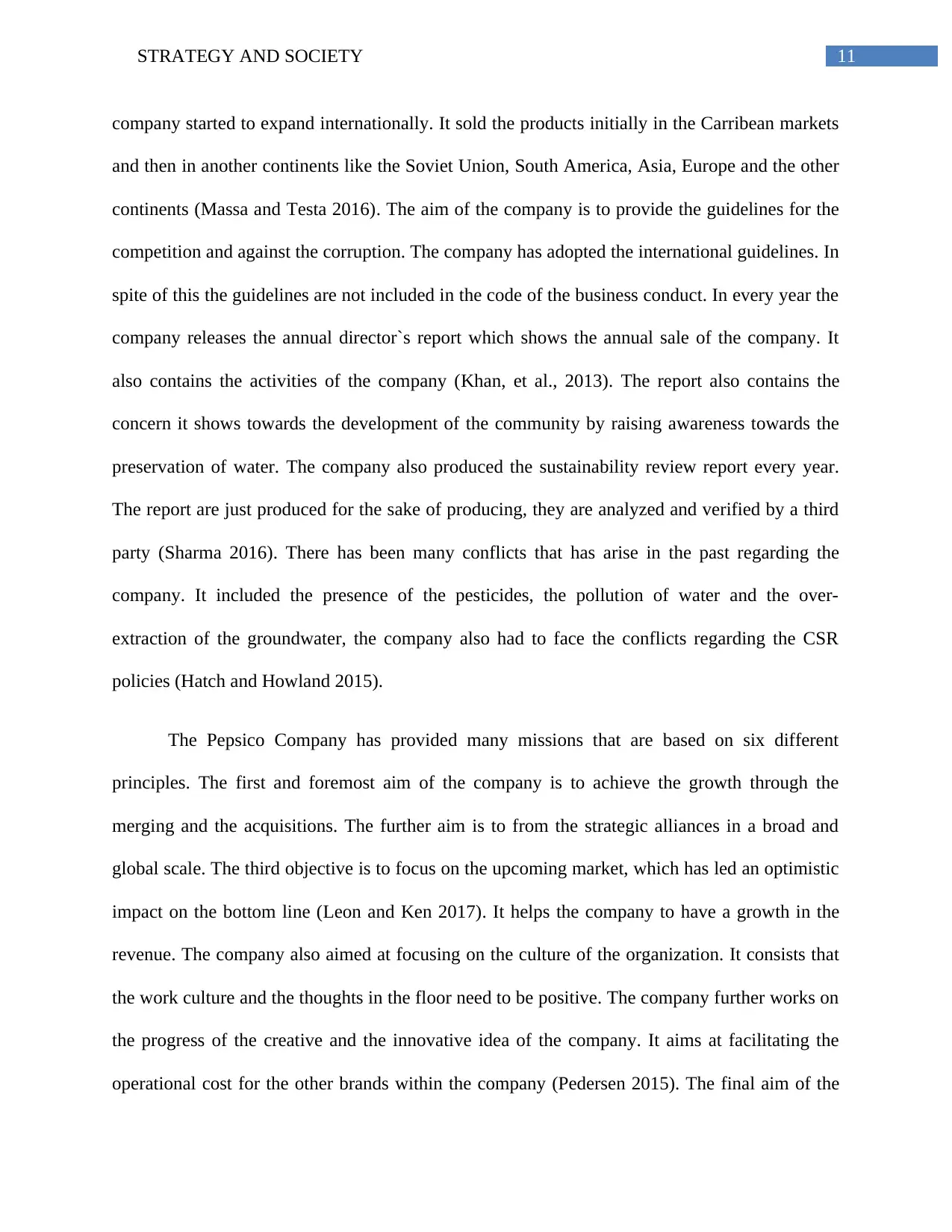
11STRATEGY AND SOCIETY
company started to expand internationally. It sold the products initially in the Carribean markets
and then in another continents like the Soviet Union, South America, Asia, Europe and the other
continents (Massa and Testa 2016). The aim of the company is to provide the guidelines for the
competition and against the corruption. The company has adopted the international guidelines. In
spite of this the guidelines are not included in the code of the business conduct. In every year the
company releases the annual director`s report which shows the annual sale of the company. It
also contains the activities of the company (Khan, et al., 2013). The report also contains the
concern it shows towards the development of the community by raising awareness towards the
preservation of water. The company also produced the sustainability review report every year.
The report are just produced for the sake of producing, they are analyzed and verified by a third
party (Sharma 2016). There has been many conflicts that has arise in the past regarding the
company. It included the presence of the pesticides, the pollution of water and the over-
extraction of the groundwater, the company also had to face the conflicts regarding the CSR
policies (Hatch and Howland 2015).
The Pepsico Company has provided many missions that are based on six different
principles. The first and foremost aim of the company is to achieve the growth through the
merging and the acquisitions. The further aim is to from the strategic alliances in a broad and
global scale. The third objective is to focus on the upcoming market, which has led an optimistic
impact on the bottom line (Leon and Ken 2017). It helps the company to have a growth in the
revenue. The company also aimed at focusing on the culture of the organization. It consists that
the work culture and the thoughts in the floor need to be positive. The company further works on
the progress of the creative and the innovative idea of the company. It aims at facilitating the
operational cost for the other brands within the company (Pedersen 2015). The final aim of the
company started to expand internationally. It sold the products initially in the Carribean markets
and then in another continents like the Soviet Union, South America, Asia, Europe and the other
continents (Massa and Testa 2016). The aim of the company is to provide the guidelines for the
competition and against the corruption. The company has adopted the international guidelines. In
spite of this the guidelines are not included in the code of the business conduct. In every year the
company releases the annual director`s report which shows the annual sale of the company. It
also contains the activities of the company (Khan, et al., 2013). The report also contains the
concern it shows towards the development of the community by raising awareness towards the
preservation of water. The company also produced the sustainability review report every year.
The report are just produced for the sake of producing, they are analyzed and verified by a third
party (Sharma 2016). There has been many conflicts that has arise in the past regarding the
company. It included the presence of the pesticides, the pollution of water and the over-
extraction of the groundwater, the company also had to face the conflicts regarding the CSR
policies (Hatch and Howland 2015).
The Pepsico Company has provided many missions that are based on six different
principles. The first and foremost aim of the company is to achieve the growth through the
merging and the acquisitions. The further aim is to from the strategic alliances in a broad and
global scale. The third objective is to focus on the upcoming market, which has led an optimistic
impact on the bottom line (Leon and Ken 2017). It helps the company to have a growth in the
revenue. The company also aimed at focusing on the culture of the organization. It consists that
the work culture and the thoughts in the floor need to be positive. The company further works on
the progress of the creative and the innovative idea of the company. It aims at facilitating the
operational cost for the other brands within the company (Pedersen 2015). The final aim of the
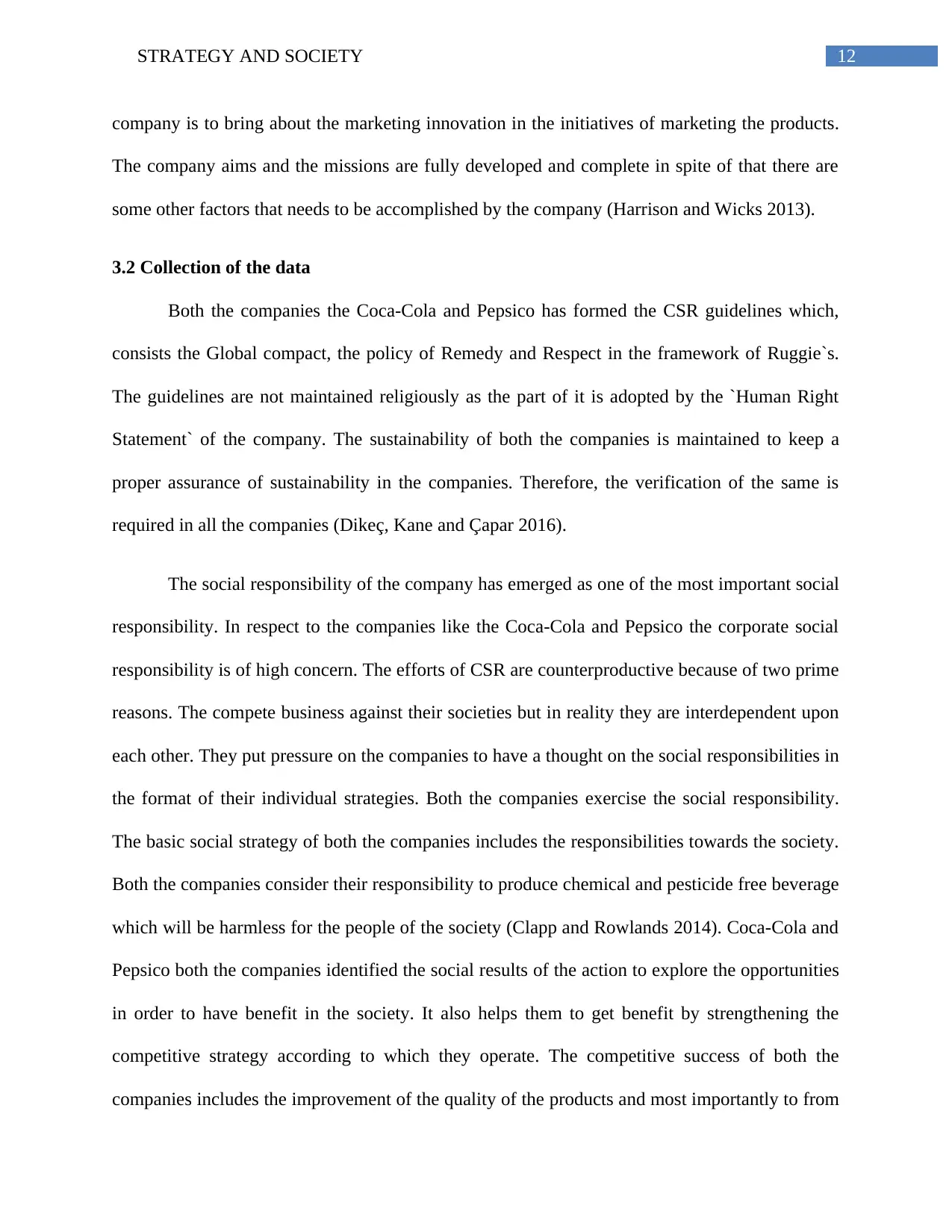
12STRATEGY AND SOCIETY
company is to bring about the marketing innovation in the initiatives of marketing the products.
The company aims and the missions are fully developed and complete in spite of that there are
some other factors that needs to be accomplished by the company (Harrison and Wicks 2013).
3.2 Collection of the data
Both the companies the Coca-Cola and Pepsico has formed the CSR guidelines which,
consists the Global compact, the policy of Remedy and Respect in the framework of Ruggie`s.
The guidelines are not maintained religiously as the part of it is adopted by the `Human Right
Statement` of the company. The sustainability of both the companies is maintained to keep a
proper assurance of sustainability in the companies. Therefore, the verification of the same is
required in all the companies (Dikeç, Kane and Çapar 2016).
The social responsibility of the company has emerged as one of the most important social
responsibility. In respect to the companies like the Coca-Cola and Pepsico the corporate social
responsibility is of high concern. The efforts of CSR are counterproductive because of two prime
reasons. The compete business against their societies but in reality they are interdependent upon
each other. They put pressure on the companies to have a thought on the social responsibilities in
the format of their individual strategies. Both the companies exercise the social responsibility.
The basic social strategy of both the companies includes the responsibilities towards the society.
Both the companies consider their responsibility to produce chemical and pesticide free beverage
which will be harmless for the people of the society (Clapp and Rowlands 2014). Coca-Cola and
Pepsico both the companies identified the social results of the action to explore the opportunities
in order to have benefit in the society. It also helps them to get benefit by strengthening the
competitive strategy according to which they operate. The competitive success of both the
companies includes the improvement of the quality of the products and most importantly to from
company is to bring about the marketing innovation in the initiatives of marketing the products.
The company aims and the missions are fully developed and complete in spite of that there are
some other factors that needs to be accomplished by the company (Harrison and Wicks 2013).
3.2 Collection of the data
Both the companies the Coca-Cola and Pepsico has formed the CSR guidelines which,
consists the Global compact, the policy of Remedy and Respect in the framework of Ruggie`s.
The guidelines are not maintained religiously as the part of it is adopted by the `Human Right
Statement` of the company. The sustainability of both the companies is maintained to keep a
proper assurance of sustainability in the companies. Therefore, the verification of the same is
required in all the companies (Dikeç, Kane and Çapar 2016).
The social responsibility of the company has emerged as one of the most important social
responsibility. In respect to the companies like the Coca-Cola and Pepsico the corporate social
responsibility is of high concern. The efforts of CSR are counterproductive because of two prime
reasons. The compete business against their societies but in reality they are interdependent upon
each other. They put pressure on the companies to have a thought on the social responsibilities in
the format of their individual strategies. Both the companies exercise the social responsibility.
The basic social strategy of both the companies includes the responsibilities towards the society.
Both the companies consider their responsibility to produce chemical and pesticide free beverage
which will be harmless for the people of the society (Clapp and Rowlands 2014). Coca-Cola and
Pepsico both the companies identified the social results of the action to explore the opportunities
in order to have benefit in the society. It also helps them to get benefit by strengthening the
competitive strategy according to which they operate. The competitive success of both the
companies includes the improvement of the quality of the products and most importantly to from
⊘ This is a preview!⊘
Do you want full access?
Subscribe today to unlock all pages.

Trusted by 1+ million students worldwide
1 out of 23
Related Documents
Your All-in-One AI-Powered Toolkit for Academic Success.
+13062052269
info@desklib.com
Available 24*7 on WhatsApp / Email
![[object Object]](/_next/static/media/star-bottom.7253800d.svg)
Unlock your academic potential
Copyright © 2020–2025 A2Z Services. All Rights Reserved. Developed and managed by ZUCOL.





